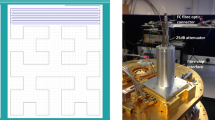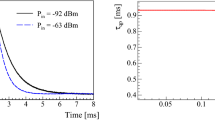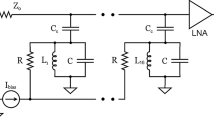Abstract
We present measurements of quasiparticle generation-recombination noise in aluminium Microwave Kinetic Inductance Detectors, the fundamental noise source for these detectors. Both the quasiparticle lifetime and the number of quasiparticles can be determined from the noise spectra. The number of quasiparticles saturates to 10 μm−3 at temperatures below 160 mK, which is shown to limit the quasiparticle lifetime to 4 ms. These numbers lead to a generation-recombination noise limited noise equivalent power (NEP) of 1.5×10−19 W/Hz1/2. Since NEP∝N qp , lowering the number of remnant quasiparticles will be crucial to improve the sensitivity of these detectors. We show that the readout power now limits the number of quasiparticles and thereby the sensitivity.
Similar content being viewed by others
Avoid common mistakes on your manuscript.
1 Introduction
Microwave Kinetic Inductance Detectors [1] (KIDs) are the most promising candidate for future space- and ground based large array imaging and imaging spectroscopy at sub-millimeter wavelengths. Several groups have already successfully demonstrated operation on a telescope [2, 3]. As in any pair breaking detector, the fundamental limit to the sensitivity is governed by random generation and recombination of quasiparticles, which we have recently demonstrated with aluminium microwave resonators [4]. Here we discuss generation-recombination noise in Al KIDs, based on the same dataset, showing that this most fundamental noise limit is now reached. We discuss the implications for detector optimisation.
2 Quasiparticle Number Fluctuations
In a superconductor in thermal equilibrium, the density of quasiparticles per unit volume is given by
valid at k B T<Δ, with N 0 the single spin density of states at the Fermi level (1.72×1010 μm−3 eV−1 for Al), k B Boltzmann’s constant, T the temperature and Δ the energy gap of the superconductor. Assuming a thermal distribution of quasiparticles and phonons, the average quasiparticle recombination time is given by [5]
where T c is the critical temperature of the superconductor and τ 0 a material dependent, characteristic electron-phonon interaction time.
In thermal equilibrium, the generation and recombination rates are equal and the variance of the random number fluctuations \(\sigma ^{2}= \langle \delta N_{qp}^{2} \rangle=N_{qp}=n_{qp}V\), with V the volume of the system. The power spectral density of these fluctuations shows a Lorentzian spectrum, given by [6, 7]
with ω the angular frequency. Equations (1) and (2) show that the product N qp τ r , which gives the level of the spectrum, is constant over temperature. One can show [5] that N qp τ r ∝1/bΔ 2, which shows that it is beneficial for observing generation-recombination noise to take a material with low b, indicating the strength of the electron-phonon coupling, and low Δ. As an example, Al has 2–3 orders of magnitude higher N qp τ r than Ta and Nb.
3 Microwave Resonator Experiment
We measure the quasiparticle number fluctuations using a high-quality microwave resonator. The high frequency response of the superconductor is controlled by the quasiparticle density through the complex conductivity σ 1−iσ 2 [8]. Quasiparticle number fluctuations will show up as fluctuations in the complex conductivity. To measure the complex conductivity, a 40 nm thick Al film was patterned into microwave resonators. The film was sputter-deposited onto a C-plane sapphire substrate. The critical temperature is 1.11 K, from which the energy gap is Δ=1.76k B T c =168 μeV. The low temperature resistivity ρ=0.8 μΩ cm and the residual resistance ratio RRR=5.2. The film was patterned by wet etching into distributed, half wavelength, coplanar waveguide resonators, with a defined central line width of 3.0 μm and gaps of 2.0 μm wide. The resonator under consideration shows its lowest order resonance at 6.61924 GHz and has a central strip volume of 1.0⋅103 μm3. The resonance curve at 100 mK shows a coupling limited quality factor of 3.87×104. The samples are cooled in a pulse tube pre-cooled adiabatic demagnetization refrigerator. Special care has been taken to make the setup light tight [4, 9], presented in detail in an accompanying paper [10].
The complex transmission of the microwave circuit is measured with a quadrature mixer and traces out a circle in the complex plane [1, 11]. We define a resonator amplitude and phase with respect to the resonance circle, as depicted in Fig. 1a. The amplitude responsivity to quasiparticles, dA/dN qp , was determined experimentally [11]. For similar resonators it is known that the sensitivity in phase is limited by two-level fluctuators [12] and that the sensitivity in amplitude, which is limited by the cryogenic low noise amplifier, is up to a factor 10 better [11].
(Color online) (a) The real and imaginary parts of the complex transmission S 21 as a function of frequency. The gray arrow indicates increasing frequency. A resonator amplitude A and phase θ are defined with respect to the resonance circle centre. (b) Power spectral density of the resonator amplitude fluctuations as a function of frequency for six different temperatures, corrected for system noise [4]. The dashed lines are Lorentzian fits to the spectra
The power spectral density due to quasiparticle number fluctuations in the resonator amplitude (also called dissipation quadrature) is given by
where τ res is the resonator ringtime given by \(\tau_{res}=\frac {Q}{\pi f_{0}}\). In this experiment τ r ≫τ res ≈2 μs, meaning that the roll-off in the noise spectrum will be determined solely by τ r if S A is dominated by quasiparticle number fluctuations.
We have measured the fluctuations in the resonator amplitude in equilibrium at the resonant frequency using a microwave power of −77 dBm (20 pW). Measurements at this power serve as an example, the power dependence is shown later on. The power spectral density is shown in Fig. 1b for various temperatures. We have corrected the power spectral density for system noise contributions by subtracting a spectrum taken off-resonance (see Fig. 1a). Before calculating the spectrum, the time-domain trace was filtered for large energy impacts [4]. We observe that the power spectral density has a constant level for all temperatures, with a roll-off frequency that increases with temperature. From these two properties we conclude that we directly observe quasiparticle generation-recombination noise.
The measured recombination time, τ r , is extracted from the resonator amplitude noise spectra and shown in Fig. 2a as a function of temperature. At temperatures from 180–300 mK, we find the expected exponential temperature dependence. Equation (2) is used to fit for the characteristic electron-phonon interaction time τ 0 and we find a value of 458±10 ns. At temperatures <160 mK we measure a temperature independent quasiparticle recombination time of 2.2 ms.
(a) The quasiparticle lifetime as a function of temperature, obtained from the roll-off frequency in the resonator amplitude spectrum. The solid line represents the lifetime calculated from theory. (b) The measured N qp and corresponding NEP due to generation-recombination noise as a function of temperature. The solid line shows the theoretical expectation
The measured level of the power spectral density and the quasiparticle lifetime are combined to obtain N qp , using (3) and (4) together with the measured dA/dN qp . The result is plotted in Fig. 2b. For temperatures above 160 mK the expected exponential temperature dependence is found. Below 160 mK, the number of quasiparticles saturates to around 30,000 (30 μm−3). The saturation in the quasiparticle lifetime (Fig. 2a) is consistent with the saturation in N qp , from which we conclude that the saturation in τ r , observed earlier [13, 14], is here due to a saturation in N qp , consistent with calculations for superconducting qubits [15].
The noise spectra are converted into noise equivalent power (NEP) through [11]
with η=0.57 an efficiency factor. The thus calculated electrical NEP at 100 mK is plotted in Fig. 3a. We find that the generation-recombination noise contribution to the NEP is 2×10−19 W/Hz1/2, which leads to NEP=3×10−19 W/Hz1/2 including system noise. We plot the low-frequency NEP as a function of temperature in Fig. 2b (right axis), in the same plot as N qp , which shows the measurements are consistent with the theoretically expected generation-recombination limited NEP:
(Color online) (a) The measured Noise Equivalent Power as a function of frequency at 100 mK. The dashed curve shows the NEP without corrections, the solid line shows the NEP for the noise spectrum corrected for system noise, giving the pure generation-recombination noise contribution to the NEP. (b) Number of quasiparticles and quasiparticle lifetime at the lowest temperatures as a function of microwave readout power, extracted from both the amplitude power spectral density (squares) and the amplitude-phase cross-PSD (triangles)
We have now reached the fundamental noise limit for KIDs, but the NEP can still be reduced. The observation that the quasiparticle lifetime is limited by the quasiparticle density reduces (6) to NEP g−r ∝N qp , thus to reduce NEP, we have to reduce N qp . As discussed earlier, we have thoroughly excluded stray light, proven in this experiment by the fact that we see no extra photon-noise on top of the generation-recombination noise. We also exclude large energy impacts visible in the time-domain data [4]. Our most recent data shows that N qp and τ r are now limited by the microwave readout power, as is shown in Fig. 3b. We find a close to linear dependence of N qp on readout power. At the lowest power n qp =10 μm−3 and τ r =4 ms, leading to NEP≈1.5×10−19 W/Hz1/2. Although this particular set of (preliminary) results might be explained by a simple heating model [16], we emphasise that on a microscopic level a more rigorous treatment will be needed, since the microwave field will significantly alter the quasiparticle distribution function [17, 18], which we hope to investigate deeper. Several other groups have shown remnant quasiparticle densities lower than 1 μm−3 in experiments with qubits [19, 20] and single-electron islands [21] using aluminium, which would make NEP≈1×10−20 W/Hz1/2 possible.
We have recently shown [22] that if a detector in the dark is limited by generation-recombination noise, it will necessarily be limited by photon-noise under illumination, bringing two fundamental limits within reach at once.
4 Conclusions
We have measured generation-recombination noise in Al KIDs. Both the quasiparticle lifetime and the number of quasiparticles can be determined from the noise spectra. The number of quasiparticles saturates to 10 μm−3 at temperatures below 160 mK at the lowest microwave power. We show that the quasiparticle lifetime is limited by that number of quasiparticles to 4 ms. These numbers lead to a generation-recombination noise limited NEP of 1.5×10−19 W/Hz1/2, which can be lowered by decreasing the quasiparticle density and the volume.
References
P.K. Day, H.G. LeDuc, B.A. Mazin, A. Vayonakis, J. Zmuidzinas, Nature 425, 817 (2003)
A. Monfardini, L.J. Swenson, A. Bideaud, F.X. D’esert, S.J.C. Yates, A. Benoit, A.M. Baryshev, J.J.A. Baselmans, S. Doyle, B. Klein, M. Roesch, C. Tucker, P. Ade, M. Calvo, P. Camus, C. Giordano, R. Guesten, C. Hoffmann, S. Leclercq, P. Mauskopf, K.F. Schuster, Astron. Astrophys. 521, A29 (2010)
J. Schlaerth, A. Vayonakis, P. Day, J. Glenn, J. Gao, S. Golwala, S. Kumar, H. LeDuc, B. Mazin, J. Vaillancourt, J. Zmuidzinas, J. Low Temp. Phys. 151, 684 (2008)
P.J. de Visser, J.J.A. Baselmans, P. Diener, S.J.C. Yates, A. Endo, T.M. Klapwijk, Phys. Rev. Lett. 106, 167004 (2011)
S.B. Kaplan, C.C. Chi, D.N. Langenberg, J.J. Chang, S. Jafarey, D.J. Scalapino, Phys. Rev. B 14, 11 (1976)
C.M. Wilson, L. Frunzio, D.E. Prober, Phys. Rev. Lett. 87, 067004 (2001)
C.M. Wilson, D.E. Prober, Phys. Rev. B 69, 094524 (2004)
D.C. Mattis, J. Bardeen, Phys. Rev. 111, 412 (1958)
J.J.A. Baselmans, S.J.C. Yates, AIP Conf. Proc. 1185, 160 (2009)
J. Baselmans, S. Yates, P. Diener, P. de Visser, J. Low Temp. Phys. (2012). doi:10.1007/s10909-012-0511-0
J. Baselmans, S.J.C. Yates, R. Barends, Y.J.Y. Lankwarden, J.R. Gao, H. Hoevers, T.M. Klapwijk, J. Low Temp. Phys. 151, 524 (2008)
J. Gao, M. Daal, A. Vayonakis, K. Shwetank, J. Zmuidzinas, B. Sadoulet, B.A. Mazin, P.K. Day, H.G. Leduc, Appl. Phys. Lett. 92, 152505 (2008)
R. Barends, J.J.A. Baselmans, S.J.C. Yates, J.R. Gao, J.N. Hovenier, T.M. Klapwijk, Phys. Rev. Lett. 100, 257002 (2008)
R. Barends, S. van Vliet, J.J.A. Baselmans, S.J.C. Yates, J.R. Gao, T.M. Klapwijk, Phys. Rev. B 79, 020509(R) (2009)
J.M. Martinis, M. Ansmann, J. Aumentado, Phys. Rev. Lett. 103, 097002 (2009)
P.J. de Visser, S. Withington, D.J. Goldie, J. Appl. Phys. 108, 114504 (2010)
B.I. Ivlev, S.G. Lisitsyn, G.M. Eliashberg, J. Low Temp. Phys. 10, 449 (1973)
J.-J. Chang, D.J. Scalapino, Phys. Rev. B 15, 2651 (1977)
M. Lenander, H. Wang, R.C. Bialczak, E. Lucero, M. Mariantoni, M. Neeley, A.D. O’Connell, D. Sank, M. Weides, J. Wenner, T. Yamamoto, Y. Yin, J. Zhao, A.N. Cleland, J.M. Martinis, Phys. Rev. B 84, 024501 (2011)
H. Paik, D.I. Schuster, L.S. Bishop, G. Kirchmair, G. Catelani, A.P. Sears, B.R. Johnson, M.J. Reagor, L. Frunzio, L. Glazman, R.J. Schoelkopf, Phys. Rev. Lett. 107, 240501 (2011)
O.-P. Saira, A. Kemppinen, V.F. Maisi, J.P. Pekola, arXiv:1106.1326v2 (2011)
S.J.C. Yates, J.J.A. Baselmans, A. Endo, R.M.J. Janssen, L. Ferrari, A.M. Baryshev, Appl. Phys. Lett. 99, 073505 (2011)
Acknowledgements
We would like to thank Y.J.Y. Lankwarden for fabricating the devices. A.E. is financially supported by NWO (Veni grant 639.041.023) and JSPS Fellowship for Research Abroad. T.M.K. likes to thank the W.M. Keck Institute for Space Sciences for partial support for his stay at California Institute of Technology, while this manuscript was written.
Open Access
This article is distributed under the terms of the Creative Commons Attribution Noncommercial License which permits any noncommercial use, distribution, and reproduction in any medium, provided the original author(s) and source are credited.
Author information
Authors and Affiliations
Corresponding author
Rights and permissions
Open Access This is an open access article distributed under the terms of the Creative Commons Attribution Noncommercial License (https://creativecommons.org/licenses/by-nc/2.0), which permits any noncommercial use, distribution, and reproduction in any medium, provided the original author(s) and source are credited.
About this article
Cite this article
de Visser, P.J., Baselmans, J.J.A., Diener, P. et al. Generation-Recombination Noise: The Fundamental Sensitivity Limit for Kinetic Inductance Detectors. J Low Temp Phys 167, 335–340 (2012). https://doi.org/10.1007/s10909-012-0519-5
Received:
Accepted:
Published:
Issue Date:
DOI: https://doi.org/10.1007/s10909-012-0519-5







